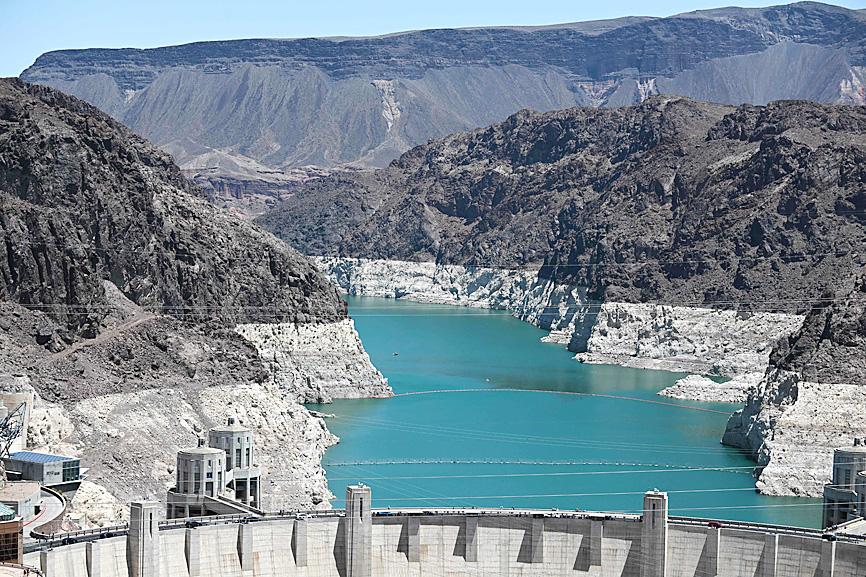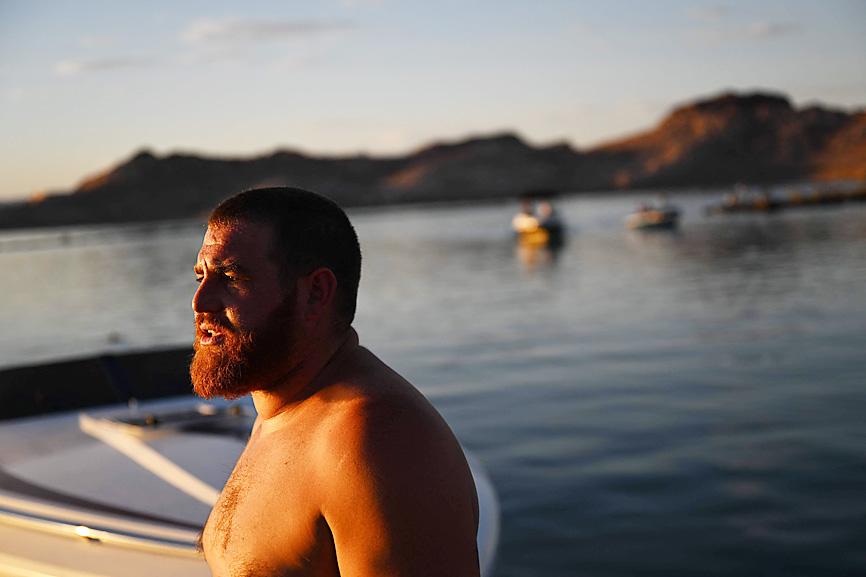Millions of liters of Colorado River water hurtle through the Hoover Dam every day, generating electricity for hundreds of thousands of homes, but the mega drought affecting the western US is sending reservoir levels plummeting toward deadpool — the point at which the dam can no longer produce power.
“We are [in a] 23rd year of drought here in the Colorado River Basin and Lake Mead has dropped down to 28 percent,” said Patti Aaron of the US Bureau of Reclamation, which operates the dam.
She was referring to the vast lake created by the building of the dam.

Photo: AFP
“There isn’t as much head, so there isn’t as much pressure pushing the water into the turbines, so there’s less efficiency and we aren’t able to produce as much power,” she said.
The Hoover Dam was a feat of hope and engineering. Construction began in 1931 as the US was withering under the Great Depression.
Thousands of workers toiled 24 hours a day to build what was then the largest hydroelectricity facility in the world. The dam stopped up the Colorado River, creating Lake Mead, the biggest reservoir in the US.

Photo: AFP
At its height, the lake surface sits more than 365m above sea level, but after more than two decades of drought it is now less than 320m — the lowest since the lake was filled, and falling about a 30cm a week.
If it drops to 290m, the intakes for the dam would no longer be under water and the turbines would stop.
“We’re working very hard for that not to happen,” Aaron said. “It’s just not an option to not produce power or not deliver water.”
The Colorado River rises in the Rocky Mountains and snakes its way through Colorado, Utah, Arizona, Nevada, California and northern Mexico, where it empties into the Gulf of California.
It is fed chiefly by the huge snowpack that gets dumped at high altitudes, melting slowly throughout the warmer months, but reduced precipitation and the higher temperatures caused by climate change means less snow is falling, and what snow there is, is melting faster.
As a consequence, there is not as much in a river that supplies water to tens of millions of people and countless hectares of farmland.
Boaters on Lake Mead, many of whom come from Las Vegas and its surrounding towns, say they are doing their part to protect supplies.
They point to drought-tolerant landscapes they have installed instead of lawns and the high percentage of indoor water that is recycled in desert towns.
“But you’ve got farmers in California growing almonds for export,” said Kameron Wells, who lives in nearby Henderson, Nevada.
Householders in southern California have grumbled about the fate of their luscious lawns since being ordered to limit their outdoor watering to one or two days a week at the start of the summer, but there, like in the desert periphery of Las Vegas, there is plenty of new construction, with huge houses being put up in the resort settlement of Lake Las Vegas.
From the air, the vibrant green of dozens of golf courses mark an otherwise dust-bowl landscape.
Climatologist Steph McAfee of the University of Nevada, Reno, says the US west has always been something of an improbability.
“The average precipitation in Las Vegas is something like four inches [10cm] a year, and to make it possible to have cities like Las Vegas and Phoenix and Los Angeles we rely on water that falls in the mountains as snow in parts of the west that are obviously much, much wetter,” McAfee said.
The past two decades of drought are not actually that unusual in climatic terms, according to tree ring reconstructions, she said.
However, “what’s going on now is that we’re having a drought and temperatures are much warmer, and when temperatures are high, things dry out faster. That is a consequence of climate change ... driven by human greenhouse gas emissions,” she said.
On Lake Mead, boat seller Jason Davis maneuvers his craft toward the Hoover Dam, where thousands of tonnes of concrete loom over the water in graceful modernist lines and a ring of mineral deposits shows where the water level used to be.
For him, the lake is not just a battery for the huge generators in the dam, but a waterscape whose beauty and peacefulness are worth protecting.
“You know, people who haven’t been here don’t appreciate it,” he said as a sunset rages in the desert sky above. “It’s like, out of sight, out of mind. Hey, we’re using too much water. Well, if you haven’t seen these rings, you don’t quite comprehend. Hopefully, it’s not too late.”

The Burmese junta has said that detained former leader Aung San Suu Kyi is “in good health,” a day after her son said he has received little information about the 80-year-old’s condition and fears she could die without him knowing. In an interview in Tokyo earlier this week, Kim Aris said he had not heard from his mother in years and believes she is being held incommunicado in the capital, Naypyidaw. Aung San Suu Kyi, a Nobel Peace Prize laureate, was detained after a 2021 military coup that ousted her elected civilian government and sparked a civil war. She is serving a

China yesterday held a low-key memorial ceremony for the 1937 Nanjing Massacre, with Chinese President Xi Jinping (習近平) not attending, despite a diplomatic crisis between Beijing and Tokyo over Taiwan. Beijing has raged at Tokyo since Japanese Prime Minister Sanae Takaichi last month said that a hypothetical Chinese attack on Taiwan could trigger a military response from Japan. China and Japan have long sparred over their painful history. China consistently reminds its people of the 1937 Nanjing Massacre, in which it says Japanese troops killed 300,000 people in what was then its capital. A post-World War II Allied tribunal put the death toll

‘NO AMNESTY’: Tens of thousands of people joined the rally against a bill that would slash the former president’s prison term; President Lula has said he would veto the bill Tens of thousands of Brazilians on Sunday demonstrated against a bill that advanced in Congress this week that would reduce the time former president Jair Bolsonaro spends behind bars following his sentence of more than 27 years for attempting a coup. Protests took place in the capital, Brasilia, and in other major cities across the nation, including Sao Paulo, Florianopolis, Salvador and Recife. On Copacabana’s boardwalk in Rio de Janeiro, crowds composed of left-wing voters chanted “No amnesty” and “Out with Hugo Motta,” a reference to the speaker of the lower house, which approved the bill on Wednesday last week. It is

FALLEN: The nine soldiers who were killed while carrying out combat and engineering tasks in Russia were given the title of Hero of the Democratic People’s Republic of Korea North Korean leader Kim Jong-un attended a welcoming ceremony for an army engineering unit that had returned home after carrying out duties in Russia, North Korean state media KCNA reported on Saturday. In a speech carried by KCNA, Kim praised officers and soldiers of the 528th Regiment of Engineers of the Korean People’s Army (KPA) for “heroic” conduct and “mass heroism” in fulfilling orders issued by the ruling Workers’ Party of Korea during a 120-day overseas deployment. Video footage released by North Korea showed uniformed soldiers disembarking from an aircraft, Kim hugging a soldier seated in a wheelchair, and soldiers and officials